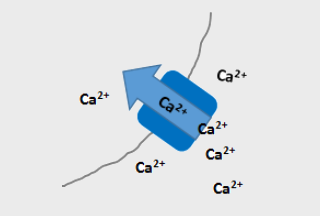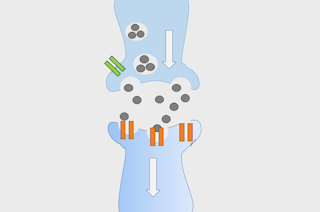Research
The overall research focus of the COMM members is on Molecular Signalling (how do cells perceive stimuli and how does the information get inside the cell and lead to reactions), Molecular Therapy Strategies (identification of new molecular targets for drugs), and Biomedical Modelling (development of computer-assisted models for a better understanding of biological, physical and chemical processes without animal testing). The research focusses of the COMM scientists can be roughly assigned to the headings below, although the boundaries are fluid. For more detailed information on the research priorities of individual members, please visit our page People, for details on the research focusses of their cooperation networks and methods used, we refer to our pages Research Networks and Methods, respectively.
Formation and Maintenance of Cellular Structures

Humans consist of approximately 100 trillion cells, which host a variety of different organelles (e.g. mitochondria, endoplasmatic reticulum, lipid droplets) and in which the vital metabolic processes take place. Thousands of different proteins within a cell catalyze chemical reactions, absorb substances from the environment, act as messenger substances, read the genetic information or give the cells their structure. The proteins move quite quickly within the cells and even many organelles are highly dynamic. Our members are interested in the mechanisms which determine the cellular architecture and analyze cellular processes directly linked to the function of individual proteins and macroscopic cellular structures.
Endocrine and Neural Signal Processing

The human brain consists of billions of neurons which are responsible for the processing of sensory perceptions and the coordination of complex behavior. The neurons, supported by glial cells, conduct excitations and transmit them to synapses via neurotransmitters as signal molecules. Several of the COMM-members investigate the molecular mechanisms underlying synaptic transmission in neurons, neuroendocrine cells and immune cells with the goal to understand how communication between these cells is mediated and modulated.
Calcium and Ion Channels

Cells of the human body, as well as their organelles are surrounded by membranes. Proteins embedded in the membranes regulate the exchange of substances between the in- and outside, e.g. pore-forming ion channels that allow electrically charged particles like Kalium-, Natrium- and Calcium ions to cross the membranes along an electrochemical gradient. A number of COMM scientists are working on the biophysical, electrophysiological and pharmacological characterization of ion channels, in particular TRP (transient receptor potential channels) and calcium channels and investigate their role in the devolpment of clinically relevant diseases.
Sensory perception and signal transmission

Our cells have to fulfil numerous functions in order to react to a changing environment and to remain healthy. For this, they have to communicate with each other e.g. by using external signals like hormones, neurotransmitter, sound waves or electromagnetic waves. These external signals can be recognized and absorbed via special cytosolic receptors (e.g. steroid receptors) and receptor proteins in the plasma membrane (e.g. ion channels) and transformed into intracellular signals (e.g. calcium ions), which then trigger respective reactions. The process is called “signal transduction” and a dysfunction of single elements can seriously compromise the normal functioning of cells and organs. It has been implicated in detrimental diseases such as immune mediated diseases, deafness, cystic fibrosis, cancer, cardiovascular dysfunction and Alzheimer’s disease.
Clinical research

The campus in Homburg is not only home to the School of Medicine of the Saarland University, but also to the Saarland University Hospital, whose Clinics and Institutes also conduct outstanding research (e.g. cardiovascular, kidney and pulmonary research, research into the molecular mechanisms of complex hepatological diseases, cancer research). A central component here is the interlocking of research and clinical patient care, which should enable all patients to receive medical care at the highest international level. The close proximity of clinicians and basic researchers on one campus, the joint involvement in the training of medical students and the cooperation within the COMM promotes a lively exchange, and thus translational research.
Statistics and Clinical Studies

Clinical studies are important tools for the translation of clinical information into basic scientific questions and reverse. Several COMM members of the Saarland University Hospital participate in national and international studies dealing e.g. with the treatment of patients with chronic obstructive pulmonary diseases such as asthma and COPD, heart failure, coronary heart disease, arterial hypertension, cardiac arrhythmia, lipid metabolism disorders, biomarker analysis and integration of genetic, epigenetic, and microbiome data with clinical datasets. Within the scope of the studies, new drugs and therapeutic procedures are being tested with regard to their efficacy and tolerability. The Institute of Medical Biometry, Epidemiology and Medical Informatics supports this research projects in the field of biostatistical analysis and medical information processing and special study centers take care of the patients who participate in clinical studies.
Genetics and Epigenetics

Some human diseases (e.g. certain forms of prostate cancer) or biological processes (e.g. spermatogenesis), can have genetic causes like mutations or recombination and the respective genes can be passed on from parents to their children. Whether the children will later suffer from the disease or not also depends on whether the genes will be switched on or not. Environmental and behavorial factors can influence the gene activities (epigentics). Thus, the COMM members do not only investigate the development of the human genome and the genetic causes of tumor diseases, they are also interested in whether and how external factors such as nutrition or the climate, influence gene activities.
Simulation and Modeling

The combination of Biology, Medicine and Pharmacy with the MINT sciences Mathematics, Informatics and Physics within several research networks of the COMM members fosters the application of approaches developed in the latter to the huge data sets or complex models commonly addressed in the former. Especially the integration of modeling techniques and simulation methods in the analysis of medical relevant systems enables a better understanding of the biological, physical and chemical processes in organs, tissues, cells, proteins and molecules. This interdisciplinar collaboration does not only reduce animal testing, but also fosters the efficient transfer of insights gained on a theoretic level into applications.
Investigated Diseases
Investigated Processes
